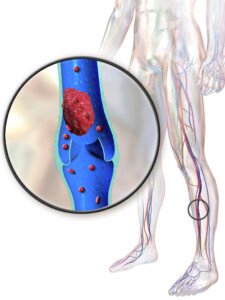
It is alarming just how many DVTs (blood clots) are missed in a patient following surgery. But why does this happen?
Patients are given blood thinners and other preventive protocols, but deep vein thromboses still do develop in some patients — and many get missed.
Nurses check a patient’s legs after surgery on a regular basis for telltale signs of a blood clot, namely swelling and redness.
However, many deep vein thromboses do not cause symptoms. But then again, not every missed DVT lacks symptoms, either!
“Yes, a significant number of DVTs remain asymptomatic, particularly if they involve the smaller (tibial) veins,” says Seyed-Mojtaba (Moji) Gashti, MD, a board certified vascular surgeon with Broward Health Medical Center in Florida.
“Even a venous Doppler has a high false negative rate when it comes to these veins.”
False negative means that a procedure missed what it was looking for.
“A lot of patients after knee or hip surgery would have pain and swelling related to their surgery anyways.
“It can be difficult to know if their symptoms are related to their surgery or DVT. It may not be practical or cost effective to study all of these patients.
“Most of these DVT’s would be labeled as provoked, most often secondary to central venous catheters.
“Generally these are focal and limited to the site of the catheter (most often in the internal jugular vein). These can be watched.”

DVT. BruceBlaus/CreativeCommons
What if more needs to be done?
“But if the thrombus extends to the subclavian/innominate veins, then most physicians would consider anticoagulation [blood thinners] if there are no contraindications,” says Dr. Gashti.
Following heart bypass surgery, a patient can bleed to death from anticoagulant drugs.
“If anticoagulation is contraindicated, then an SVC filter would be indicated,” says Dr. Gashti.
SVC stands for superior vena cava, a large vein that transports de-oxygenated blood from the upper body to the heart.
“The SVC is much shorter than the IVC [inferior vena cava], and therefore placement of a filter in the SVC is technically more challenging.
“You have to make sure the length is adequate. Currently there are no filters in the market indicated for SVC and if you place one, it would be off label.”
Dr. Gashti adds that he has placed only a handful of these devices in 20+ years of practice.










































